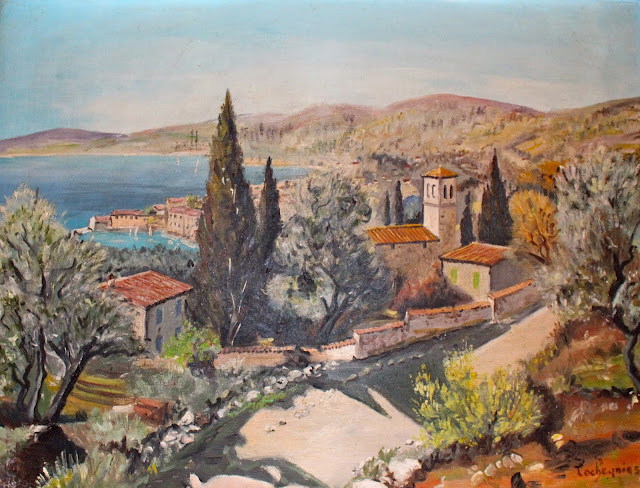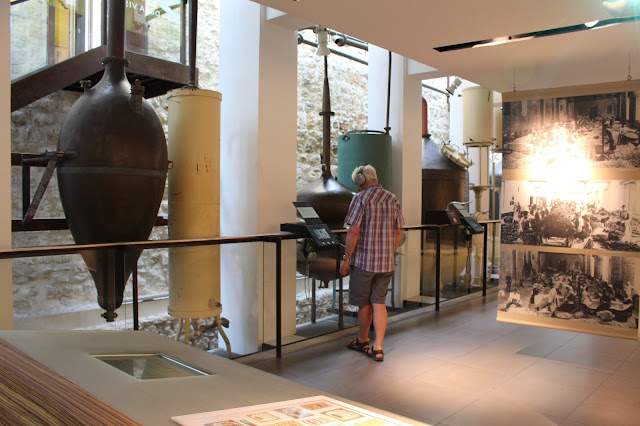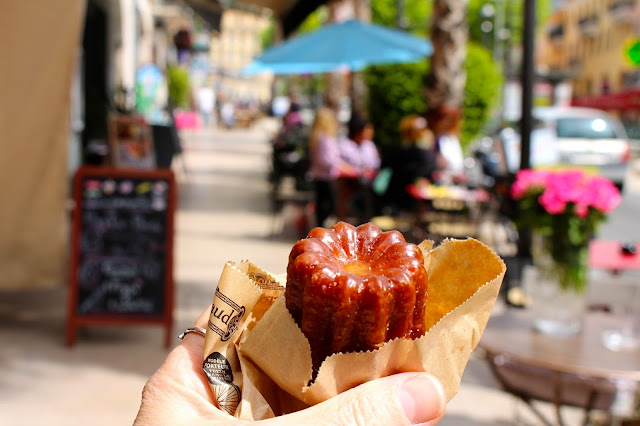The charming, 15th century hilltop village of Biot was once an important pottery manufacturing center specializing in large earthenware oil and wine containers.
Metal containers brought an end to this, but Biot is still active in handicraft production, especially glassmaking.
Sandi checks out the olive selection at the outdoor market. Almost every town in Provence has at least one a week.
Stall-holders in Antibes loudly ply their wares which include fruits, vegetables, flowers, trays of saucissson (dry-cured sausage) and cheeses to sample.
Speaking of food, it's time for lunch. Crepes and a pichet of rosé have become our standard daily fare.
With its boat-bedecked port, 16th century ramparts and narrow cobblestone streets festooned with flowers, lovely Antibes is the quintessential Mediterranean town. The Church of the Immaculate Conception is painted in cheery Provençal colours—terra-cotta and yellow.
Pablo Picasso once wrote, ‘If you want to see the Picassos from Antibes, you have to see them in Antibes’. Spectacularly positioned overlooking the sea, 14th century Château Grimaldi served as Picasso's studio from July-December 1946. Now a museum, the Musée Picasso houses an excellent collection of the master's paintings, lithographs, drawings and ceramics.
Another fine acquisition for Sandi—a silk scarf with a Picasso design, an early birthday present from Tim.
Walking among the couture shops and palaces of La Croisette in Cannes, you'd be forgiven for thinking that the global downturn was all media hype. There is as much wealth and glamour as ever, and admiring Ferraris and Porsches and celebrity-spotting in the liner-sized yachts are still favourite Cannes pastimes.
As for the world-famous film festival, it is not the most visitor-friendly event: think stratospheric prices and insider-only attendance. It is, however, celebrity-spotting at its very best. We plan our time here a few days before the onslaught of the festival.
The multi-starred hotels and couture shops that line the famous bd de la Croisette (aka La Croisette) may be the preserve of the rich and famous, but anyone can enjoy the palm-shaded promenade and take in the atmosphere. In fact, it's a favourite amongst Cannois (natives of Cannes), particularly at night when it's lit with bright colours.
The elaborate 1871 Splendid Hotel has everything it takes to rival the nearby palaces.
The most historic church, Notre Dame d'Espérance, was built between 1521 and 1641 and combines both Gothic and Renaissance elements.
La Plage de la Croisette.
Pétanque (Provençal boules) was invented in La Ciotat, near Marseille, in 1910 when arthritis-crippled Jules Le Noir could no longer take the running strides prior to aiming demanded by the longue boule game. The local champion thus stood with his feet firmly on the ground—a style that became known as pieds tanques (Provençal for ‘tied feet’, from which pétanque emerged).
Tim likey.
Sandi likey.
The Majestic Barrière Hotel has stood for glamour since 1926. It's a favourite with celebs during the film festival and beloved by the Parisians.
Built in 1912, the Carlton once attracted the most prominent members of Europe's haut monde. Today this legendary hotel is more democratic, booking lots of conventions and tour groups. Its twin cupolas were modelled on the breasts of the courtesan La Bell Otéro, infamous for her string of lovers—Tsar Nicholas II and Britain's King Edward VII among them.
We're in Mougins at at the Musée d'Art Classique de Mougins. The brainchild of compulsive art collector and British entrepreneur Christian Levett, this outstanding museum contains 600 works spanning 5000 years of history. Sandi stands next to Le Pouce, César's sculpture in bronze.
The collection aims to show how ancient civilization inspired neoclassical, modern and contemporary art, so you'll therefore find antiquities juxtaposed with seminal modern works. Not only is it a brilliant idea, it has also been brilliantly executed.
One of the museum's most stunning displays is a window exhibiting an antique Roman Venus in white marble standing next to a resin and plaster-cast Venus by Yves Klein in signature blue, with a surreal giraffe-necked statue by Dalí and the Birth of Venus by Andy Warhol in the background.
Pinprick Vieux Mougins looks almost too perfect to be real. Picasso discovered the medieval village in 1935 and lived here until his death. Since then Mougins has become something of an elite location with prestigious hotel-restaurants, the country's most sought after international school, and Sophia Antipolis (France's Silicon Valley) nearby.
Tim scouts out tonight's dining options and selects Le Petit Fouet replete with beams, chandeliers, barmen crooning along to old French songs and a parrot that peers down at you while you eat.
Provençal legend has it that painting window shudders blue-grey fools mosquitos into thinking it's the sky and they don't fly in.
Steph Cop's sculptures carved from 100-year-old fallen trees.
Opened in 2012 by the Musée International de la Parfumerie in Grasse, these gardens beautifully complement the museum's collection by offering an insight into the plants used in perfumery. Visitors are actively encouraged to pick, rub and smell their way around.
The gardens are organized by olfactive families (woody, floral, ambered, etc.).
We're back at Le Petit Fouet for dinner. Radishes and salt is a popular appetizer in France. Sounds boring but it isn't.
Pou-pou the Parrot has his eye on Tim's chocolate mousse.
We roll into Grasse just as the annual International Rose Festival gets under way.
The whole city is decorated in roses.
La vie en rose, non?
Sandi loves this vintage painting of Provence so Tim adds it to her growing collection of early birthday presents.
Rose water mist pumped through the streets from above scents the air.

It is the abundance of water in the hills that helped turn Grasse into a perfume center. Tanners, who needed reliable water supplies to clean their hides, first settled here in the Middle Ages. With the advent of perfumed gloves in the 1500s, the art of perfumery took shape. Glove makers split from the tanners and set up lucrative perfumeries. New irrigation techniques allowed flower growing to boom, sealing Grasse's reputation as the world fragrance capital.
Today, Grasse is still surrounded by jasmine, centifolia roses, mimosa, orange blossom and violet fields, but the industry, which counts some 30 perfumeries, is rather discreet, with only a handful offering tours of their facilities. The Musée International de la Parfumerie, housed in a renovated 18th century mansion, daringly enlarged with a modern glass structure, retraces three millennia of perfume history through a brilliant mix of artifacts, bottles, videos, vintage posters, olfactive stations and explanatory panels.
Tim gets happy, happy sniffing all the fragrances.

Sandi admires the extensive collection of rare and antique perfume bottles.
The private Musée Fragonard is tiny but fantastic and houses France's second-largest collection of works by Grassois painter Jean-Honoré Fragonard (1732-1806). There are 15 major works, beautifully exhibited in a renovated 18th century town house.
You can get your hair done for the occasion too.
A canelé is a small French pastry with a soft and tender custard center and a dark, thick caramelized crust. Irrésistible!
Almost every building in Provence has a roof that looks like this.
Nicknamed the ‘Grand Canyon of Europe’, the plunging Gorges du Verdon slices a 25km swathe through Haute-Provence's limestone plateau—the foothills of the Alps.
Under the protection of the Parc Naturel Régional de Verdon since 1997, the gorges create habitat for incredible birds, including the canyon's very own colony of reintroduced griffon vultures.
The spectacular main gorge begins at Rougon, near the confluence of the Verdon and Jabron Rivers; the emerald-green waters wind westward toward Lac de Ste-Croix.
The narrow canyon bottom is just 8m to 90m wide. Its walls rise a dizzying 250m to 700m—at their highest, over twice the height of the Eiffel Tower.
Overhanging rims widen from 200m to 1500m. It's best to see the gorges from above and below, if possible.
A complete circuit of the Gorges du Verdon from Moustier Ste-Marie involves 140km of relentless hairpin turns. Next up, Moustier and the hill towns of the Luberon.





















































































No comments:
Post a Comment